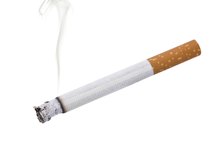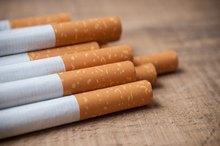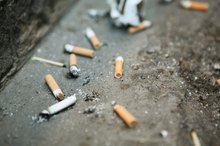Factors That Influence People to Smoke
Smoking tobacco is part of many societies and cultures. It is also a major cause of many diseases, including cancers. There are many factors that play significant roles in influencing people to smoke, but the most common ones appear to be peer pressure, family history of smoking and the tobacco industry's advertising and media campaigns portraying smoking as a glamorous and socially accepted behavior.
Family Smoking
Family smoking and role models are significant factors in influencing young children to smoke. An article in the Journal of Consumer Affairs by Karen H. Smith and Mary Ann Stutts, reported that the most important factors associated with smoking are family smoking behavior, peer pressure and prior beliefs about smoking. Young people tend to imitate their parents behavior. In addition to the notion that smoking is an acceptable behavior, children often see smoking as grown-up behavior, which further encourages them to smoke. Children from families where smoking is prevalent tend to develop the habit and are less likely to quit later in life.
- Family smoking and role models are significant factors in influencing young children to smoke.
- An article in the Journal of Consumer Affairs by Karen H. Smith and Mary Ann Stutts, reported that the most important factors associated with smoking are family smoking behavior, peer pressure and prior beliefs about smoking.
Peer Pressure
Smoking Peer Pressure Facts
Learn More
Peer pressure is a significant factor for many people who start to smoke. Economic status, educational level and family history are significant factors that determine the level of peer pressure and the consequences of such pressures. A 1993 study by Cornelia Pechmann, published in Marketing Science Institute, concluded that prior beliefs refer to the images and ideas about smoking that children develop before any formal anti-smoking education. Often these beliefs are subconsciously held and are resistant to education.
- Peer pressure is a significant factor for many people who start to smoke.
Advertising and Media
As with any other type of advertising, advertising by tobacco companies hopes to influence people to smoke. A study published in Journal of Consumer Research by researcher Cornelia Pechmann, concluded that adolescents are influenced and affected by the type of tobacco advertising and media they are exposed too. Although the ways in which tobacco companies can reach the public have been curtailed by legislation, the effects can still be seen by marketing campaigns using cartoon characters, giveaways and free samples.
Related Articles
References
- Questia: Factors That Influence Adolescents to Smoke
- Centers for Disease Control and Prevention (CDC). Current Cigarette Smoking Among Adults In The United States. Office on Smoking and Health, National Center for Chronic Disease Prevention and Health Promotion. Updated November 18, 2019.
- American Lung Association. What’s In A Cigarette? ALA Smoking Facts. Updated August 20, 2019.
- Centers for Disease Control and Prevention (CDC). Recognize Signs Of Depression. Office on Smoking and Health, National Center for Chronic Disease Prevention and Health Promotion, Centers for Disease Control and Prevention. Updated April 1, 2019.
- Centers For Disease Control And Prevention (CDC). Smoking And Heart Disease And Stroke. Office on Smoking and Health, National Center for Chronic Disease Prevention and Health Promotion, Centers for Disease Control and Prevention. Updated January 28, 2019.
- Centers for Disease Control and Prevention (CDC). Heart Disease Facts. National Center for Chronic Disease Prevention and Health Promotion, Division for Heart Disease and Stroke Prevention. Updated December 2, 2019.
- Centers for Disease Control and Prevention (CDC). Infographics - Tobacco Use And Cardiovascular Disease. CDC Global Health. Updated May 29, 2018.
- Centers For Disease Control And Prevention (CDC). Fast Facts. Office on Smoking and Health, National Center for Chronic Disease Prevention and Health Promotion. Updated November 15, 2019.
- World Health Organization (WHO). Tobacco. WHO Fact Sheets. Updated July 26, 2019.
- Centers for Disease Control and Prevention (CDC). Current Cigarette Smoking Among Adults In The United States. Office on Smoking and Health, National Center for Chronic Disease Prevention and Health Promotion. Updated November 18, 2019.
- American Lung Association. What’s In A Cigarette? ALA Smoking Facts. Updated August 20, 2019.
- Centers for Disease Control and Prevention (CDC). Recognize Signs Of Depression. Office on Smoking and Health, National Center for Chronic Disease Prevention and Health Promotion, Centers for Disease Control and Prevention. Updated April 1, 2019.
- Centers For Disease Control And Prevention (CDC). Smoking And Heart Disease And Stroke. Office on Smoking and Health, National Center for Chronic Disease Prevention and Health Promotion, Centers for Disease Control and Prevention. Updated January 28, 2019.
- National Institutes of Health (NIH). Smoking And Your Heart. National Heart, Lung, And Blood Institute (NHLBI). Updated March 12, 2013.
- National Institutes of Health (NIH). Smoking And Bone Health. NIH Osteoporosis And Related Bone Diseases National Resource Center. Updated December 2018.
- Aldaham S, Foote JA, Chow HH, Hakim IA. Smoking status effect on inflammatory markers in a randomized trial of current and former heavy smokers. Int J Inflam. 2015;2015:439396. doi:10.1155/2015/439396
- Qiu F, Liang CL, Liu H, Zeng YQ, Hou S, Huang S, et al. Impacts of cigarette smoking on immune responsiveness: Up and down or upside down?. Oncotarget. 2017;8(1):268-284. doi:10.18632/oncotarget.13613
- Centers For Disease Control And Prevention (CDC). Smoking During Pregnancy. Office on Smoking and Health, National Center for Chronic Disease Prevention and Health Promotion. Updated January 25, 2018.
- Moylan S, Gustavson K, Øverland S, Karevold EB, Jacka F, Pasco J, et al. The impact of maternal smoking during pregnancy on depressive and anxiety behaviors in children: the Norwegian Mother and Child Cohort Study. BMC Med. 2015;13(1). doi:10.1186/s12916-014-0257-4
- American Cancer Society. The Tobacco Atlas. Sixth. (Drope J, Schluger N, eds.). Atlanta: American Cancer Society; 2018:20-31.
- Centers For Disease Control And Prevention (CDC). Children In The Home. Office on Smoking and Health, National Center for Chronic Disease Prevention and Health Promotion. Updated February 8, 2018
- Gometz ED. Health effects of smoking and the benefits of quitting. Virtual Mentor. 2011;13(1):31-5. doi:10.1001/virtualmentor.2011.13.1.cprl1-1101
- The American Cancer Society medical and editorial content team. Health Risks Of Smoking Tobacco. American Cancer Society. Updated November 15, 2018.
Resources
Writer Bio
Health expert and network TV/radio/Internet host, Dr. Susan Jewell has appeared on CBS, Fox News, ABC and NBC. She is a health blogger and producer, and currently produces several webisode/TV series on "how-tos on health and living green." Dr. Jewell trained in clinical research medicine in cancer and AIDS/HIV at NIH and UCLA.








